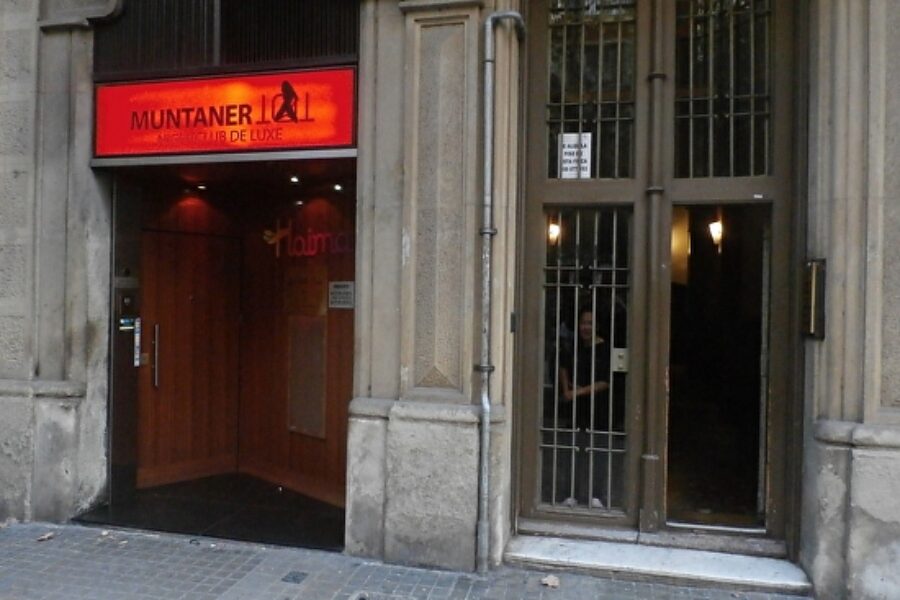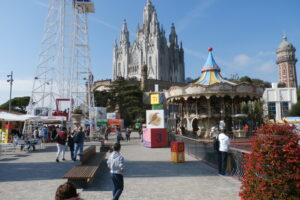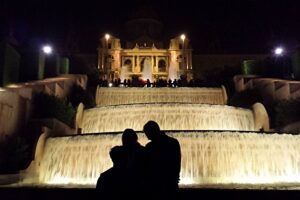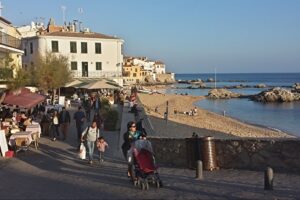Waiting for our plane to Barcelona at the small Basel airport, the food options are few. We decide on pre-prepared sandwiches, glass sized bottles of wine, and English crisps at a tiny kiosk across from our gate. We wait in line to leave the terminal and walk across the tarmac before climbing too many steps to board the plane. I have two heavy bags, and no free hands to hold onto the railing, and I think I can do this. At least I hope I can do this. Paying extra to be part of the first group boarding and for exit row seating, I don’t remember the cost, but it whatever it was, it is worth it.
Landing in Barcelona
In Barcelona, I discover that flying EasyJet is like being a second-class citizen. The plane is great, everyone professional, but the airport relegated the worst jetway for our use in deplaning. It feels like we are in a different terminal than when we landed here five weeks ago. No one cares about our passports or that we are American citizens. I call Graciela and let her know we have landed.
We follow the sign to baggage claim, climbing onto two separate people movers to increase our pace. As we walk off the last conveyor belt the baggage claim signs are gone. We walk on. Nothing.
“Michael,” I say, “I think baggage claim is back that way.”
We retrace our steps then walk alongside the conveyor belt, going backward to its forward motion. We turn left, take the escalator down and find baggage claim. It is a ghost town. No bags. No people. Around the corner, away from anyone’s sight line is EasyJet’s baggage claim information. We are on carousel 24. No one is here. The carousel doesn’t move—all I can think is Not again! I look beyond the end of the carousel. Next, to a wall, probably fifteen feet apart are two lonely looking suitcases.

We grab and go.
An Apartment in Eixample Neighborhood
It worries me that the taxi drivers GPS doesn’t accept the exact address of our apartment. We are 101—it only acknowledges 103. We speed through the streets of Barcelona in the dark of night, dodging traffic. The only thing that registers is large buildings and many, many brightly lit streets. We continue on toward the L’Eixample neighborhood—laid out in neat squares with wide streets fronted with an array of shops and 19th-century apartment buildings; the streets lined with a forest of trees.
After a few turns, the taxi stops and tells us we are here. Motorcycles line the sidewalk. As I exit the taxi I see a bright pink door—a strip club.
“Michael, don’t let the taxi leave, we may not be in the right place.” We can’t be in the right place.

Unbelievably we are. We make our way into the 19th-century apartment building, trying to find our way to the first floor. I walk up some stairs and ring the bell. A voice calls down from above—“No Charlotte it is up here. You have to take the elevator.” It is a tight squeeze; the elevator will hold only me and my suitcases. Michael must wait. The lift is ancient. And complicated.
After Graciela shows us around and explains things we decide bed is the only answer to our exhaustion. Mike climbs in bed first. “Charlotte, there isn’t a top sheet.” Again! This is the fourth time. Finca Portizuela. Amsterdam. The Emerald Dawn. And now. What is with this no top sheet thing? I am too tired to solve the problem tonight.
Beginnings and endings— they xupa. A Catalan word.
Rick Steves said we’d be happy – I can only hope…

For a refreshing break from the dense old city, head north to the modern Eixample neighborhood, with its wide sidewalks, graceful shade trees, chic shops, and Art Nouveau frills. Barcelona was busting out of its medieval walls by the 1850s, and so a new town — called the Eixample, or Expansion — was laid out in a grid pattern. The original vision was an egalitarian one: Each 20-block-square district was to have its own hospital and large park, markets, schools, and daycare centers.
But over time the Eixample became a showcase for wealthy residents and their Catalan architects, who turned the flourishing Art Nouveau style into Modernisme, their own brand of decorative design. Buildings bloom with characteristic colorful, leafy, and flowing shapes in doorways, entrances, facades, and ceilings.
Rick Steves https://www.ricksteves.com/watch-read-listen/read/articles/barcelona-a-visual-feast










Leave a Reply
Your email is safe with us.